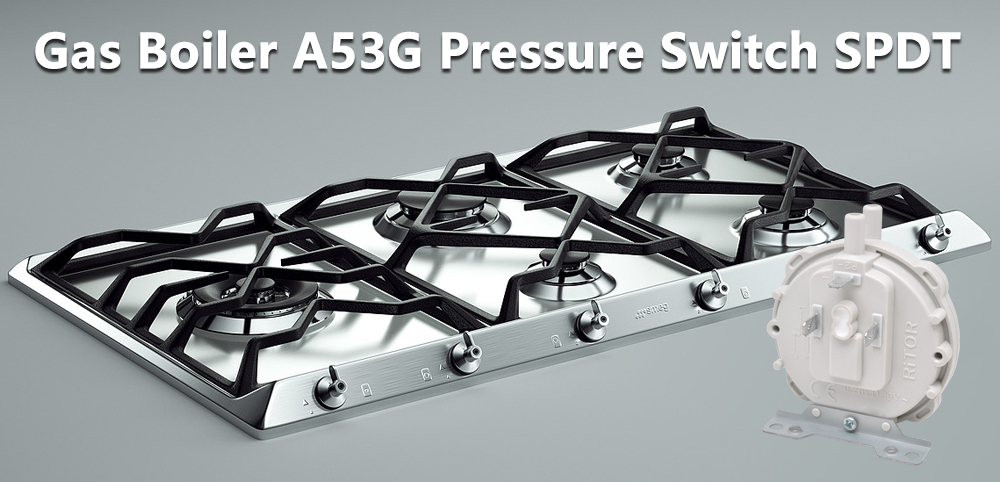Gas boiler A53G pressure switch negative SPDT 50-300Pa
Gas boilers are an important part of many heating systems, providing warmth and comfort to homes and commercial buildings. One of the key components of a gas boiler is the A53G air pressure switch, which plays a vital role in ensuring the safe and efficient operation of the boiler. In this guide, we will focus on the A53G Gas Boiler Air A53G Pressure Switch Negative SPDT 50 – 300Pa and explore its features, functions and benefits.
The gas boiler air A53G pressure switch is a device used to monitor the air pressure inside the boiler combustion chamber. This switch plays an important safety and control role, ensuring that the gas boiler operates within the appropriate gas pressure range.
Gas Boiler Negative Pressure SPDT 50 – 300Pa Air A53G pressure switch is a key component of the gas boiler system, ensuring safety, efficiency and reliability. By monitoring and controlling air pressure, this switch contributes to the smooth operation of the boiler and helps maintain optimal performance.

Learn about gas boiler air A53G pressure switch
The gas boiler A53G air pressure switch is a negative pressure switch designed to monitor and control the air pressure in the boiler. It operates in the range of 50 – 300 Pa, ensuring that pressure remains within specified limits for optimal performance.
The SPDT configuration of the A53G pressure switch means it has three terminals: common, normally open, and normally closed. This allows flexibility in wiring and enables the switch to perform different functions depending on the specific requirements of the boiler system.
The gas furnace A53G pressure switch is a device used to monitor and control the gas pressure inside the gas furnace. Its role is to ensure that the gas furnace is operating within a safe range and to take appropriate measures to maintain proper gas pressure when needed.
The main function of the gas furnace A53G pressure switch is to monitor the gas pressure in the combustion chamber. If the gas pressure exceeds the safe range, the A53G pressure switch may trigger the corresponding control mechanism to ensure the safe operation of the gas furnace.
The A53G pressure switch is an important safety device in gas furnaces. When too high or too low gas pressure is detected, the switch can trigger an emergency shutdown, alarm or other safety measures to avoid potentially dangerous situations. The A53G pressure switch can be integrated with the gas supply system to regulate the flow of gas to ensure proper combustion conditions are maintained under different conditions.
The A53G pressure switch may also be able to detect malfunctions in your gas furnace system, such as gas line leaks or valve issues, providing even more comprehensive safety and performance protection.
-
Table of Contents
ToggleMonitor air pressure
The air pressure switch measures the air pressure inside the combustion chamber. This is important because combustion requires a certain gas pressure to ensure adequate combustion. Monitoring air pressure refers to measuring the air pressure level within a specific area or piece of equipment. In gas boilers, monitoring air pressure is to ensure that the gas pressure in the combustion chamber is within a safe and effective range.
For gas boilers, the purpose of monitoring air pressure is to ensure that the gas pressure in the combustion chamber is within a safe range. If the pressure is too high or too low, it may cause safety issues such as explosion or incomplete combustion. By monitoring air pressure, the system can adjust the mixture of gas and air for more efficient combustion. This helps improve combustion efficiency and reduce energy waste.
Monitoring of air pressure can be used to control the combustion process to ensure it meets design specifications and performance requirements. Devices that monitor air pressure include pressure sensors or pressure switches. These devices measure gas pressure and send corresponding signals to the system. If the pressure exceeds a predetermined range, the system can take automatic measures, such as adjusting the gas valve or stopping the gas supply, to ensure safe and efficient operation.
-
Security protection
If the air pressure exceeds the set range, the switch may trigger corresponding safety mechanisms, such as shutting off the gas supply, to avoid danger caused by excessive pressure. Safety protection is crucial in gas boilers, and monitoring air pressure is one of these aspects.
Gas boilers are usually equipped with over-pressure protection devices. When the air pressure in the combustion chamber exceeds a safe range, this device triggers and takes measures, such as closing the gas valve, to prevent overloading the system and reduce the risk of explosion. Conversely, too low pressure can also cause problems, such as insufficient combustion. Therefore, a safety system might monitor air pressure and, when it becomes too low, automatically take steps to maintain pressure within a safe range.
In an emergency, the gas supply can be cut off by an emergency shut-off device. This prevents continued burning in unsafe conditions. When the safety system detects abnormal air pressure, it may cause the entire gas boiler system to be shut down to ensure that no dangerous situation continues to occur. Gas boiler equipment is equipped with an alarm system that will sound an alarm when abnormal conditions are detected to remind the operator or system maintenance personnel to take necessary measures.
-
Control combustion
The air pressure switch can also be used to adjust the combustion efficiency of gas boilers. By monitoring air pressure, the system can adjust the mixture of gas and air for more efficient combustion. Controlling combustion is one of the key aspects of ensuring that gas boiler operation is safe, efficient and environmentally friendly. Gas boilers are usually equipped with electronic combustion control systems. These systems use sensors to monitor various parameters during the combustion process, such as oxygen concentration, gas flow, and combustion temperature. Based on these monitoring data, the control system can adjust the mixing ratio of gas and air to achieve the best combustion effect. The ratio of gas to air is critical to the efficiency of combustion. The proportional control valve is used to adjust the mixing ratio of gas and air to meet combustion needs. This ensures complete combustion, reduces exhaust emissions, and improves the boiler’s energy efficiency.
By monitoring the oxygen concentration in the combustion chamber, the system can adjust the supply of gas and air to ensure adequate oxidation reactions, thereby improving combustion. This helps reduce harmful gases produced by incomplete combustion. Another important aspect of controlling combustion is the ignition system. An advanced ignition system ensures reliable ignition and automatically re-ignites when needed. Temperature control is also critical to controlling the combustion process. The system may monitor the temperature within the combustion chamber and adjust combustion conditions as needed to prevent overheating or cooling.
Features and Benefits
The main function of the gas boiler A53G air pressure switch is to monitor the air pressure within the boiler and ensure that it remains within the required range. If the pressure falls below or rises above the set limit, the switch activates and sends a signal to the boiler control system to take appropriate action.
This switch helps maintain the correct air pressure, preventing any potential danger or malfunction that may result from low or high pressure conditions. By continuously monitoring and controlling air pressure, the switch ensures the boiler operates at optimal efficiency, reducing energy consumption and maximizing performance. The gas boiler air A53G pressure switch is designed to withstand the rigors of boiler operation, providing reliable and consistent performance over time. The switch is designed to be compatible with a variety of gas boiler models, making it a versatile option for different heating systems.
